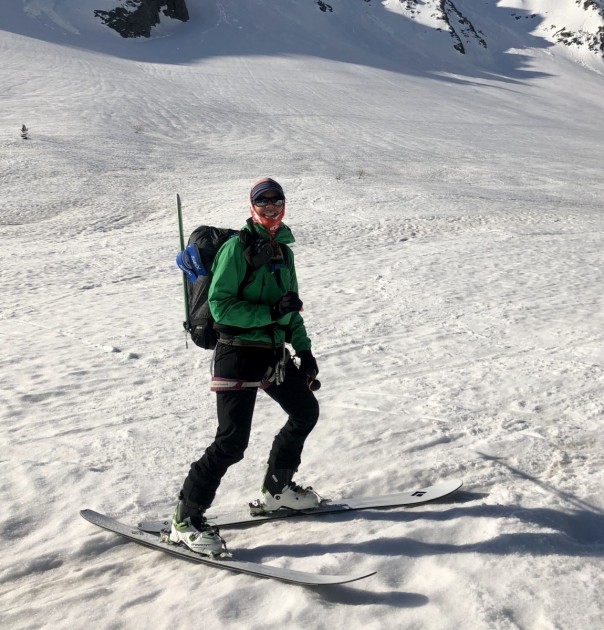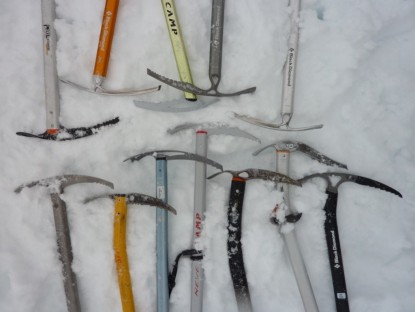CAMP Corsa Review

Our Verdict
Our Analysis and Test Results
The CAMP Corsa is one of the lightest rated ice axes currently on the market; if weight is your number one priority, look no further. The Corsa does make some sacrifices in its versatility and some of its performance characteristics, but for the right user or application, this niche axe is a perfect choice. While it lacks versatility, it's quite functional for what its intended purposes are.
The Corsa is most at home with ski mountaineers, early season backpackers, alpine rock climbers, adventure racers, and anyone else where weight is the biggest factor. Climbers needing only basic requirements of an axe will enjoy the Corsa's nearly unnoticeable weight. Mountaineers looking for a durable axe or one that will chop steps and climb steep snow efficiently will be unhappy with the Corsa's sub-par performance in those categories. Those carrying an ice axe “just in case” will love the Corsa, while climbers with a quiver of axes will find that with it, they can save an extra half-pound or more on certain general mountaineering trips when conditions are right.
Self-Arresting
This model self-arrests smoothly and effectively as long as conditions aren't too firm, something that could be said about most ice axes, but it just needs to be slightly less icy with this model to be effective. Its pick is 100% aluminum and is the only such model we tested with that design. As a result, the pick must be made wider to accommodate the slightly weaker material (compared to more common steel picks).
Digging and Step Chopping
The adze is one of the most significant sacrifices this model makes to save weight. In all of our testing, we didn't find any application that it excelled in; you'd be bumming if you had to dig out a tent platform in icy conditions. This is fine as a just in case axe while backpacking, for use while ski-mountaineering when you likely have a shovel, or when approaching alpine rock climbs (where you simply need it to add security on snow).
Use As Improvised Anchor
This is the lightest CEN-B/UIAA Type 1 ice axe that we know of; this rating means it is suitable for use as an improvised anchor during crevasse rescue or belaying off of while ascending steep snow climbs (not vertical ice climbs). There are many aspects of CEN-B versus CEN-T, but one of the most commonly applied is that when used as a T-slot or a deadman, a CEN-B rated model needs to be able to withstand a 2.5 KN (versus a T rating that needs to withstand 3.5 KN).
We would hesitate to pound many pickets with this model for fear of damaging the aluminum head - which will happen if you try it. We hammered two MSR snow pickets in moderately firm snow for the sake of the review and already put several deep dents into the head of the axe. Its small 100% aluminum adze doesn't dig snow anchors well; as such, it's designed to be lightweight and comfortable. For most ski mountaineering applications, early season backpacking, or basic snow routes, this is less of a big deal as its rare that you'll need to build anchors; in the case of ski-mountaineering, you'll likely have a shovel.
Steep Ice and Snow
Despite its 100% aluminum head, the Corsa is capable of adding security during steep booters or in less moderate terrain, as long as conditions weren't too firm or icy. Its aluminum pick is wide and doesn't penetrate firm snow or ice very well. The aluminum pick also dulls far more quickly than steel versions.
While we wouldn't want to climb any sustained steep snow or ice with this axe, it will get the job done for short sections, as long as it's not too firm. Most of the weight is in the head of this model, giving decent swing for a 7.2-ounce axe. Another nice touch is at the bottom of the shaft; there are six machined grooves to help provide better grip while swinging. While not designed for technical routes, all of our testers found themselves swinging (piolet traction) the Corsa more frequently rather than just daggering it in order to get more purchase.
This was especially true while pulling over a moat to gain an alpine rock climb or negotiating a bergschrund. Like many ultralight models, the Corsa doesn't have a spike, and the bottom of the shaft is cut at a 45-degree angle.
Comfort to Carry
Like many European manufacturers, the Corsa is most pleasant to carry in the self-belay/piolet canne position (pick forward). However, it, along with the nearly identically designed CAMP Corsa Nanotech, was the least comfortable axe to carry in self-arrest position (pick backward), as it doesn't feel natural whatsoever.
Weight
Low weight is why you buy this ice axe. At 7.4 ounces for the 50cm length, this is the lightest CEN-B rated ice axe in the world. Sure it makes some sacrifices in its functionality and versatility but performs well so long as conditions aren't too firm. Do we need to remind you how light it is?
The Corsa used to be the lightest model by far; in recent years, several models closed in. The next closet models in weight are the Petzl Ride (8.4 oz) and CAMP Corsa Nanotech (8.7); the Nanotech is identical save for a short steel pick riveted onto the end of its aluminum pick and a short steel spike.
One small thing we became aware of is that the shaft of our 50cm doesn't have a plug in the bottom; as a result, snow can become packed in while plunging it in the snow. Just remember to give it a good fling and clear the snow before stowing it again (several of our testers became proficient at flinging snow at partners and fellow testers).
Value
It isn't as versatile as others, but for certain applications, it works quite well. This model likely won't be your only ice axe, which can hurt its overall value. Value is in the eye of the beholder, and it is the lightest rated ice axe on the market. If you want better steep climbing performance check out the CAMP Corsa Nanotech, which is nearly identical to the Corsa except it has a sharp steel pick riveted onto the end.
Conclusion
The CAMP Corsa is the lightest ice axe on the market; despite its 100% aluminum design, it's more versatile than we originally thought. While it performs poorly at anchor construction, chopping steps, or for anything that involves using its micro-sized adze, it climbs steep-ish snow and self-arrests fine as long as conditions aren't too firm. For many, this isn't an all-purpose model or likely the only axe you'll own, unless you live in the Colorado Rockies, High Sierra, or similar mountain ranges. For applications like alpine rock climbing, ski-mountaineering, or early season backpacking, this model provides all the security you need without weighing you down.
| Awards | |
|---|---|
| Price | $120 List Check Backcountry (on sale!) |
Overall Score  |
|
| Star Rating | |
| Bottom Line | One of the lightest rated ice axes on the market, it's ideal for basic mountaineering |
| Pros | Lightest B-rated ice axe on the market, comfortable to carry in self-belay position, provides decent security in steeper terrain |
| Cons | Little adze, no spike, pick doesn't penetrate ice or firm snow well, no plug in shaft |
| Rating Categories | CAMP Corsa |
| Self-Arresting (15%) | |
| Digging & Step Chopping (15%) | |
| Use as Improvised Anchor (15%) | |
| Steep Ice & Snow (25%) | |
| Comfort to Carry (5%) | |
| Weight (25%) | |
| Specifications | CAMP Corsa |
| Measured Weight | 7.4 oz/209 g |
| Category | Ultralight |
| Rating | CEN-B |
| Pick Shape, Material, and Construction | Forged aluminum pick, classic positive curve |
| Lengths Available | 50, 60, 70 cm |
| Included Pommel or Leash? | No |
| Hammer Option | No |
| Shaft Design | Straight |
















